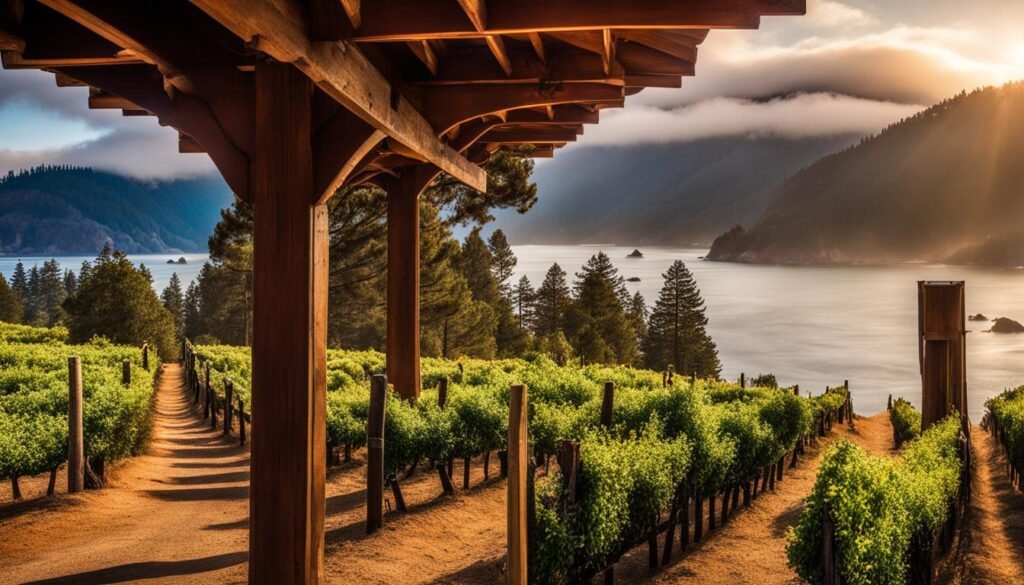California is home to a thriving population of bears, with their numbers steadily increasing in recent years. With an estimated 17,000 to 23,000 black bears spread across 52,000 square miles, these majestic creatures have found ample habitat in the Golden State.
Recognizing the significance of bears as a valuable resource, California has implemented various regulations to protect them. Monitoring procedures track population, habitat, hunting recreation, wildlife viewing opportunities, research, law enforcement, and depredation, to ensure the well-being of these iconic animals.
Key Takeaways:
- California’s black bear population is estimated to be between 17,000 and 23,000 bears.
- The state regulations aim to protect black bears and maintain a healthy population.
- Monitoring procedures track various aspects of bears, including population, habitat, and behavior.
- Public education and awareness play a crucial role in bear management.
- Responsible bear tourism provides opportunities to observe bears in their natural habitat.
Bear Species and Habitat in California
In California, there are two recognized subspecies of black bears: the northwestern black bear (Ursus americana altifrontalis) and the California black bear (Ursus americana californiensis). These subspecies are distinguished by their geographic location along the crest of the Klamath Mountains.
California’s bear habitat is divided into three regional subpopulations: North Coast/Cascade, Sierra, and Central Western/Southwestern.
- The North Coast/Cascade subpopulation, located north and west of the Sierra Nevada Mountains, has the highest bear density. It is characterized by publicly owned or timber production land, providing ample habitat for bears in this region.
- The Sierra Nevada subpopulation spans from Plumas County to Kern County, encompassing a diverse range of ecosystems and habitats that support bear populations.
- The Western/Southwestern subpopulation extends from Monterey County to Riverside County, offering a mix of urban and natural landscapes where bears can be found.


Bears play a vital role in California’s ecosystems, and understanding their species and habitat is crucial for conservation efforts. By preserving and protecting their habitats, we can ensure the continued existence of these magnificent creatures in the wild.
Bear Safety and Encounters in California
When it comes to bear encounters in California, it is essential for both residents and visitors to be well-informed and prepared. By following bear safety tips and being aware of their behavior, we can minimize the potential risks and manage bear-human conflicts effectively.
One of the key bear safety tips is to secure garbage cans properly. Bears are attracted to the smell of food, and leaving garbage bins unsecured can invite them into residential areas. By using bear-proof containers or storing garbage in a secure location, we can significantly reduce the likelihood of attracting bears.
Removing potential food sources from the vicinity is another important practice. Bears have a keen sense of smell and can be attracted to pet food, bird feeders, or even fruit trees. By ensuring that these food sources are inaccessible to bears, we can help prevent their presence in areas where they may come into conflict with humans.
When camping or hiking in bear country, it is crucial to keep campsites clean. This means properly disposing of food waste and packing away any scented items. Bears are motivated by food, and an unclean campsite can easily attract them. By adopting proper cleanliness and hygiene practices, we minimize the risk of bear encounters in wilderness areas.
While hiking or exploring bear habitat, it is recommended to make noise. Bears are generally shy and will avoid human contact if they are aware of our presence. By making noise, such as talking, clapping, or singing, we alert bears to our presence and give them an opportunity to move away safely.
If you do encounter a bear, it is important to remain calm. Running or climbing trees is not a recommended course of action, as bears are fast runners and excellent climbers. Instead, keep a safe distance and back away slowly, without turning your back on the bear.
Wildlife organizations like WildCare and Marin Humane play a crucial role in bear education and conservation efforts. They advise against following or approaching bears, as this can agitate them and lead to potential conflicts. Reporting bear sightings to these organizations helps monitor bear behavior and movements, enabling better management of bear-human conflicts.
Stay Safe, Stay Informed
By practicing bear safety tips and being aware of bear encounters in California, we can coexist with these magnificent creatures in a responsible manner. Remember, responsible behavior and respect for their habitat are essential for the well-being of both humans and bears. Together, we can better manage bear-human conflicts and ensure the conservation of California’s bear population.
Bear Conservation and Tracking in California
Conservation efforts are crucial for the long-term survival of bears in California. The Department of Fish and Game conducts population monitoring using various methods such as cementum annuli analysis, sex ratio assessment, hunter take surveys, and population estimates. This data is vital for making informed decisions regarding bear management and conservation.
Tracking bears’ movements and understanding their habitat preferences play a significant role in managing conflicts with humans and ensuring the preservation of bear populations. By monitoring their behavior and tracking their whereabouts, wildlife authorities can take proactive measures to minimize bear-human conflicts and protect both humans and bears.
California’s diverse bear habitat ranges from the lush forests of the North Coast/Cascade subpopulation to the majestic Sierra Nevada Mountains and the Central Western/Southwestern region. Each habitat offers unique challenges and requires specific conservation strategies tailored to the local ecosystem.
Efforts are underway to educate the public about the importance of bear conservation. By raising awareness about responsible behavior in bear habitats, such as proper waste disposal and minimizing attractants, we can contribute to the long-term well-being of California’s bear population.
![]()
![]()
Keeping a watchful eye on bear populations, their movements, and their habits is essential to protect these magnificent creatures and the delicate balance of California’s ecosystems. Through continued research, monitoring, and conservation initiatives, we can ensure the sustainable coexistence of humans and bears in our beautiful state.
Responsible Bear Tourism in California
In California, visitors have the opportunity to engage in responsible bear tourism, allowing them to witness the beauty of these majestic creatures in their natural habitat. One popular destination for bear viewing is Bear Valley in California, where enthusiasts can experience firsthand the wonder of observing bears in the wild.
For those seeking a more educational experience, the San Diego Zoo offers a chance to explore bear species and learn about conservation efforts. With its vast expanse spanning over 100 acres, the San Diego Zoo is a renowned institution that provides an in-depth understanding of bears and their conservation needs in California.
When participating in bear tourism activities, it is crucial to prioritize the safety of both humans and bears. Following bear safety tips is essential to ensure a positive and secure experience. Maintaining a safe distance from the bears and refraining from any actions that may disturb or harm them is of utmost importance, as it contributes to their overall well-being and natural behavior.
Conclusion
Bears are integral to the diverse ecosystems of California and serve as a valuable resource. As the bear population in the state continues to grow, it is crucial to prioritize bear conservation efforts and promote responsible bear tourism. By following bear safety tips, respecting their habitat, and reporting sightings to wildlife organizations, we can ensure the harmonious coexistence of humans and bears in a safe and sustainable manner.
By being educated about bear behavior and taking necessary precautions, we can help protect these magnificent creatures for generations to come. It is important to remember that bear encounters can be avoided by securing garbage cans, removing food sources, and keeping campsites clean. Additionally, making noise while hiking can help alert bears and prevent surprise encounters.
California’s bear conservation efforts rely on public participation and awareness. By reporting sightings to wildlife organizations, we contribute to tracking bear movements, behavior, and population trends. This information helps in making informed decisions for effective bear management and conservation strategies. Together, we can ensure the preservation of bears and their habitats for future generations to admire and appreciate.
FAQ
How many black bears are there in California?
According to the Black Bear Management Plan from July 1998, California’s black bear population ranges from 17,000 to 23,000 individuals.
What are the two recognized subspecies of black bears in California?
California is home to the northwestern black bear (Ursus americana altifrontalis) and the California black bear (Ursus americana californiensis).
Where can bears be found in California?
California’s bear habitat is divided into three regional subpopulations: North Coast/Cascade, Sierra, and Central Western/Southwestern.
How can I prevent bear encounters and manage conflicts in California?
Some safety tips include securing garbage cans, removing potential food sources, keeping campsites clean, and making noise while hiking. It’s important to handle bear encounters calmly and avoid running or climbing trees.
How can I contribute to bear conservation efforts in California?
By reporting bear sightings to wildlife organizations and following bear safety guidelines, such as maintaining a safe distance and respecting their habitat, you can help preserve and protect bear populations in the state.
Where can I participate in responsible bear tourism in California?
Bear Valley in California is popular for bear viewing, and the San Diego Zoo offers educational experiences about bear species and conservation efforts.









